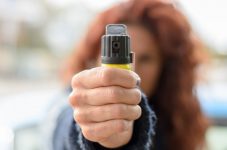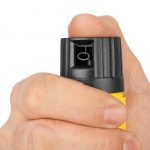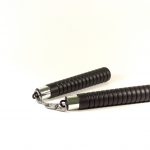Should We Be Allowed to Carry ‘Prohibited Weapons’ for Self-Defence?

A Queensland senator recently called upon the Federal Government to allow Australians to import and buy pepper spray and Tasers for self-defence.
Katter Australia Party’s Fraser Anning, who moved the motion in the upper house, argued it is the government’s duty to ensure “innocent victims are protected from harm” in the wake of a spate of “horrific violent crimes against women”.
The motion was ultimately defeated by 46 votes to 5, but the proposal has triggered a broader conversation about the scope of current laws and whether there is a need to relax the rules.
Current legislation in NSW
The Weapons Prohibition Act 1998 (NSW) commenced operation on 8 February 1999.
Under section 3, the principles of the Act are:
- to confirm that the possession and use of prohibited weapons is a privilege that is conditional on the overriding need to ensure public safety, and
- to improve public safety by imposing strict controls on the possession and use of prohibited weapons.
The same section describes the specific objectives of the Act as:
- to require each person who possesses or uses a prohibited weapon under the authority of a permit to have a genuine reason for possessing or using the weapon,
- to provide strict requirements that must be satisfied in relation to the possession and use of prohibited weapons, and
- to provide an amnesty period to enable the surrender of prohibited weapons.
Courts are meant to consider these principles and objectives when sentencing defendants for firearm offences.
Section 7(1) of the Act makes it an offence to “possess or use a prohibited weapon unless the person is authorised to do so by a permit.”
The maximum penalty if the case is finalised in the District Court is 14 years’ imprisonment, and carries a four year ‘standard non parole period’ – which is a guidepost or reference point for the judge when determining the minimum time a person must spend in prison before being eligible for release.
The maximum penalty is two years’ imprisonment and/or a $5,500 fine if the case remains in the Local Court.
Subsection 2 states that a permit holder is guilty if he or she:
- possesses or uses the weapon for any purpose other than in connection with the genuine reason given, or
- contravenes any condition of the permit.
What is a prohibited weapon?
Schedule 1 of the Act contains an extensive list of prohibited weapons, the descriptions of which can be summarised as:
The following knives:
- flick knives or other similar devices;
- ballistic knives that propel a knife-like blade;
- sheath knives which withdraw into a handle by gravity or centrifugal force;
- urban skinner push daggers;
- trench knives;
- butterfly knives or “balisongs”;
- star knives.
The following military-style weapons:
- any bomb, grenade, rocket, missile or mine or other similar device (such as a tear-gas canister) that is in the nature of, or that expels or contains, an explosive, incendiary, irritant, gas or smoke, and whether or not it is live, has been deactivated or is spent;
- any device intended for use by a military or defence force and that is designed to propel or launch a weapon;
- any flame thrower that is of military design or any other device that is capable of projecting ignited incendiary fuel.
The following ‘miscellaneous weapons’:
- spear guns with an overall length of less than 45cm;
- crossbows;
- slingshots, other than those that are home-made and for use by children in the course of play;
- saunders “Falcon” hunting slings;
- blow-guns or blow-pipes capable of projecting darts;
- darts capable of being projected from a blow-gun or blow-pipe.
- farallon shark darts;
- dart projectors known as Darchery dartslingers;
- maces other than those that are ceremonial;
- flails;
- whips with a lash comprised wholly or partly of metal;
- whip known as a cat-o’-nine-tails, or any other whip that consists of a handle to which there is attached any number of knotted lashes;
- Kung fu sticks or “nunchaku”, other than those produced and identified as children’s toys;
- side-handled batons, other than those produced and identified as children’s toys;
- extendable or telescopic batons;
- hand-held defence or anti-personnel device that administer electric shocks on contact;
- Tasers and their cartridges;
- knuckle-dusters;
- sap gloves;
- studded gloves;
- pepper spray, or other defence or anti-personnel capable of discharging any irritant matter.
- acoustic or light-emitting anti-personnel device designed to cause permanent or temporary incapacity or to otherwise disorientate persons.
- body armour vests;
- handcuffs except those which are antique handcuffs, children’s toys, or designed to be released by the wearer;
- silencers;
- detachable firearms magazine that are rimfire rifle magazines with a capacity of more than 15 rounds, a centre-fire self-loading rifle magazines with a capacity of more than 5 rounds, or centre-fire rifle magazine (other than a self-loading rifle magazine) with a capacity of more than 10 rounds,
- shotgun magazines with a capacity of more than 5 rounds,
- tubular magazine extensions;
- pistol magazines with a capacity of more than 10 rounds,
- any magazines designed to be attached to any machine gun, sub-machine gun or other firearm that are capable of propelling projectiles in rapid succession following one pressure of the trigger;
- brass catchers;
- portable tyre deflation devices;
- caltrops
- laser pointers that consists of a hand-held battery-operated device with a power output of more than 1 milliwatt;
- devices designed to propel or launch a bomb, grenade, rocket or missile by any means other than by means of an explosive, including a device known as a PVC cannon.
What is a genuine reason?
Applicants must have a “genuine reason” to possess a prohibited weapon, which under section 11 includes:
- Recreational/sporting purposes;
- Historical re-enactment purposes;
- Business/entertainment purposes;
- Film/TV/theatrical purposes;
- Weapons collection as part of an approved collectors’ club;
- Public museum purposes;
- Heirloom;
- Animal management; or
- Legitimate scientific purposes.
It is important to note that section 11(3) states that “The possession or use of a prohibited weapon for personal protection, or for the protection of any other person, is not a genuine reason for the possession or use of the weapon.”
Under section 12, permit holder must notify the Commissioner of Police within 7 days if their genuine reason for possession ceases to exist.
It is evident that the listed prohibited weapons vary in terms of dangerousness, which is a factor that can be taken into account during the sentencing process where a person has pleaded guilty or been found.
The vast differences between utility as a weapon of self-defence and dangerousness to the public has led to calls for a regime that makes it easier to possess certain items – such as pepper spray and portable devices capable of emitting electricity – and imposes even harsher penalties on those who possess destructive items such as various military weaponry.
However, the recent senate motion suggests that it may be some time before Australians are given greater access to self-defensive weapons of any type.







